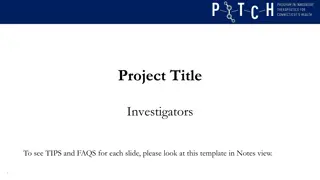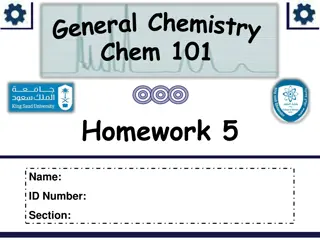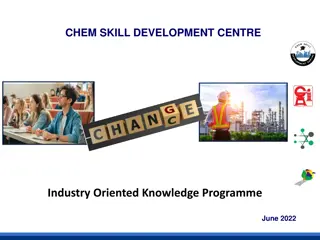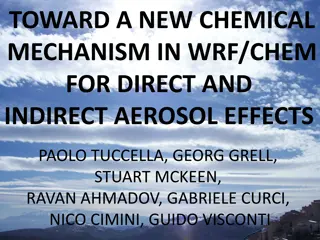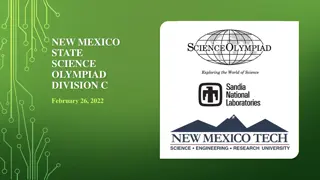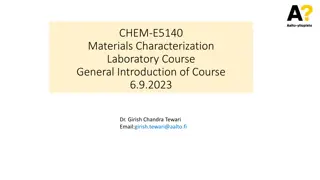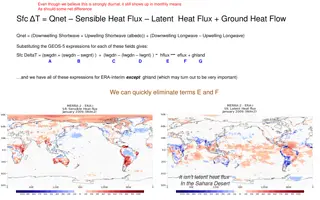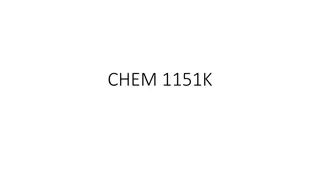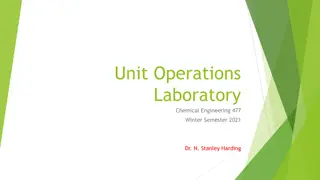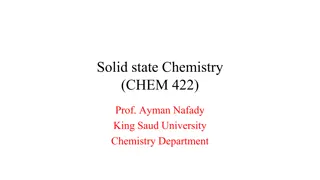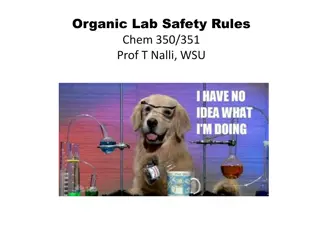Organometallic Chemistry (CHEM 42 1)
Organometallic chemistry delves into compounds with carbon-metal bonds, merging concepts from inorganic and organic chemistry. The field encompasses diverse compounds like ferrocene and tris(triphenylphosphine)rhodium carbonyl hydride, with nomenclature based on naming organic groups and adding meta
1 views • 13 slides
Advancements in Chemical Mechanisms for Air Quality Management
Daniel Jacob and team have been enhancing chemical mechanisms in the GEOS-Chem model to support US air quality management. Ongoing work includes developing new mechanisms for aromatic VOCs, tropospheric halogens, mercury redox, adaptive mechanism reduction, machine learning applications, and unifica
0 views • 19 slides
Understanding Serial Dilutions for Bio/Chem/Pharm Students
Introduction to serial dilutions for biochemistry, chemistry, and pharmacy students. Learn how to calculate solution quantities, determine volumes based on different strengths, and convert concentrations effectively in various scenarios. Practical examples provided to enhance understanding. Useful r
0 views • 9 slides
Comprehensive Research Project Overview
This project overview template provides a structured approach for presenting key aspects of a research project, including the two-year goal statement, project team background, scientific background, research plan, assay feasibility assessment, med chem feasibility assessment, and clinical correlatio
0 views • 12 slides
General Chemistry Chem 101 Homework Review
This homework assignment covers various topics in general chemistry, including gas expansion work calculations, heat transfer, enthalpy of formation, and specific heat calculations. Each question presents a different scenario for students to apply their knowledge and problem-solving skills. The ques
0 views • 7 slides
Industry-Oriented Knowledge Programme by CHEM.SKILL.DEVELOPMENT.CENTRE June 2022
CHEM.SKILL.DEVELOPMENT.CENTRE (CSDC) offers an industry-oriented knowledge programme to bridge the gap between theory and practice. The objectives include enhancing employability, providing practical knowledge, building confidence, and understanding industry practices. The programme's strategy invol
0 views • 14 slides
Advancements in Chemical Mechanisms for Aerosol Effects in WRF/Chem Model
This study focuses on the development of a new chemical mechanism in the Weather Research and Forecasting with Chemistry (WRF/Chem) model to address the underestimation of carbonaceous aerosols. The RACM/MADE/SOA-VBS mechanism incorporates advancements in gas-phase chemistry and particle parameteriz
0 views • 12 slides
New Mexico State Science Olympiad Division C Highlights
Experience the excitement of the New Mexico State Science Olympiad Division C event held on February 26, 2022. Various challenging competitions like Anatomy and Physiology, Aerial Scramble, Astronomy, Botany, Bridges, Cell Biology, Chem Lab, Codebusters, and Cybersecurity showcased the talents of pa
0 views • 32 slides
Materials Characterization Laboratory Course Overview
Learning about material characterization in the CHEM-E5140 Materials Characterization Laboratory Course includes understanding physical and chemical properties of various materials, such as bulk, surfaces, and nanostructures. The course structure involves lectures, lab sessions, assignments, and end
0 views • 48 slides
Understanding Water Variability and Cloud Formation near Tropical Tropopause
Exploring the horizontal variability of water and its relation to cloud fraction using aircraft observations to enhance grid-scale cloud formation representation in GEOS-5. Addressing the chronic water vapor issue in GEOS-5, potential causes, motivating science questions, and methodologies to improv
0 views • 17 slides
Analysis of Surface Temperature and Heat Flux Relationships
Exploring the interplay between surface temperature, sensible heat flux, latent heat flux, and ground heat flow, utilizing data from GEOS-5 and ERA-interim models to understand the impact of different heat flux components on surface temperature variations in diurnal cycles and monthly means. Compari
0 views • 8 slides
Chemistry 1151K Course Overview and Chapters Summary
Upon completion of the CHEM 1151K course, students will apply the scientific method to investigate chemical questions in allied health, utilize dimensional analysis to solve quantitative problems, communicate effectively using chemical terminology and symbols, describe the behavior of biochemical so
0 views • 44 slides
GEOS-Chem Atmospheric Chemistry Model Overview
GEOS-Chem, developed by Daniel J. Jacob at Harvard University, is a global model of atmospheric composition used to understand human and natural influences on the environment. The model addresses various atmospheric chemistry issues on different scales, from local to global, and is regularly updated
0 views • 19 slides
Unit Operations Laboratory Chemical Engineering Winter Semester 2021
Dr. N. Stanley Harding, a seasoned Chemical Engineering professional, introduces the Chem. Eng. 477 Unit Operations II course focusing on transferring theoretical knowledge to practical experience. The laboratory experiments cover various engineering principles such as separations, continuous distil
0 views • 13 slides
Enhancing Air Quality Forecasting with TEMPO Retrievals in Proxy Observing System
Improvements in Air Quality Forecast Skill (AQFS) are explored by assimilating TEMPO retrievals in a Proxy Air Quality Observing System (AQOS) using WRF-Chem/DART. The study focuses on benefits identified through a designed OSSE scenario, including application to the Front Range Air Pollution and Ph
0 views • 8 slides
Understanding Solid State Chemistry: Principles and Classification of Solids
Solid State Chemistry (CHEM 422) explores the principles and concepts governing the synthesis, structure, bonding, reactivity, and properties of solid state materials. The course delves into crystalline vs. amorphous solids, highlighting categories like ionic, molecular, metallic, and covalent solid
0 views • 24 slides
Organic Lab Safety Rules - Chem 350/351
Chemical safety is paramount in the organic lab. Always wear splash-proof goggles, report injuries promptly, and know the locations of safety equipment. Submit pre-lab plans, work in fume hoods, wear gloves as instructed, and follow lab schedules. Unauthorized experiments and food/drink are prohibit
0 views • 35 slides



